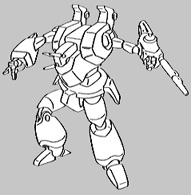

Designation:Main Battle Robot MBR-10 mk II/III Excalibur |

|
||||

|
|||||
| Total Height: | 9.0m |
| Total Depth: | 4.0m |
| Total Breadth: | 6.5m |
| Weight: | 20.6 metric tons (dry) |
| 23 metric tons (fully loaded). |
OPTIONAL:
The armor on the Excalibur is a new development in low-mass composite-materials Chobham plating that became the standard for all Terran mecha after its application to the VQ-6A Vandal. Aside from the respectable protection provided against projectiles, missiles, and other kinetic weapons, this armor is also resistant to plasma globes (annihilation discs), lasers, and to a lesser extent, particle guns, owing to the fact that the armor can flake off and evaporate in layers under fire from such high-energy weapons, taking much of the weapon's energy and converting it into the latent heat of sublimation in the armor. The armor stops all small arms, heavy infantry weapons fire, and light mecha-mounted weaponry, and provides excellent resistance to medium mecha-mounted weaponry, such as the Valkyrie's 55mm APFSDS round, and fair resistance to heavy mecha-mounted weaponry, such as the VHT's 120mm smoothbore shells.
The Excalibur provides full protection from nuclear, biological, and chemical hazards, using an overpressure cockpit environment activated by radiation and hazardous chemical sensors, or manually when biological warfare conditions are anticipated. The internal consumables supplies can provide atmosphere for three days maximum.
After the First Robotech War, the advancing knowledge of Robotechnology made the growing REF draw up specifications for a complement/successor to the well-known Tomahawk heavy Destroid. The new mecha, the Excalibur Destroid, was to correct the flaws of the Tomahawk, while keeping its strong points. Of course, because the Excalibur would be lighter than the Tomahawk, some weapon capacity would have to be sacrificed, but it was hoped that the new Destroid would compensate the loss of certain small areas of expertise with a wider array of capabilities. As with the Tomahawk and its derivatives, the Excalibur's leg and lower torso sections would be standardized with those of the Shark and the Catapult.
Entering service in 2021, the mk II fit its intended combat parameters well. As the best points of the Tomahawk were its heavy particle beams, coupled to a powerful close-in weaponry and extensive missile batteries, mounted on a heavily armored chassis, the Excalibur was to have these qualities in abundance. Meanwhile, the lesser points of the Tomahawk design - the relatively slow speed, lack of hands and the overabundant and varied weapon systems - were to be rectified.
For these reasons, the Excalibur mk II had even more missiles than its predecessor, namely 12/30 MR/SR vs. the 6/24 SAM/SR mix of the Tomahawk. However, the Excalibur had only one heavy particle beam, but because this was such a lethal weapon, the engineers managed to convince the REF procurations board that this was an acceptable configuration, and in battle this turned out to be correct. The major change in weapon systems was in the short range gun clusters. Where the Tomahawk had featured two gun clusters in the torso with two machine-guns in the head, the Excalibur had one torso installation with three GU-14 heavy caliber autocannons. These cannons were mounted with more freedom of movement than the TZ-III gun clusters on the Tomahawk were, and although they did not fire as heavy shells as the 180mm grenades in the gun clusters, these three cannons could generate a significant amount of fire. Even so, because the weapons were the short, single-barreled version of the GU-13, penetration and accuracy dropped rapidly after a relatively short effective distance. But the good number of shells often compensated for this. As requested by the REF, the Excalibur was faster than the Tomahawk, but just as heavily armored, thanks to the new low-density Chobham developed a few years earlier. However, the Excalibur lacked in anti-personnel weapons, which the crews considered a small price for the advanced capabilities of this mecha.
As the REF began to phase out the 35mm ammunition for the GU-13 and GU-14, and the guns that fired it, it was decided in 2041 to introduce an improved Excalibur. This version sacrificed the MR missile launchers for a heavy shoulder-mounted particle beam, a descendant of the EP-1 gun of the First Robotech War. Since the MR missiles were considered to be a vital part of the Excalibur's armament, the Excalibur mk III was issued a 5-round MR missile launcher in place of the triple autocannon mount. This Excalibur version was less effective at short range than the mk II, but did well against the newer mecha of the Regess, where the particle beam, with its better penetration and range, far outclassed the short range, limited penetration 35mm cannons.
The Tomahawk Destroid was not made obsolete by the Excalibur mecha, and was refitted with improved weapon systems. This REF Tomahawk was superior even to the Excalibur in a stand-and-fight situation, but was far outclassed by the Excalibur in mobility and lighter battlefield uses. Therefore, the Tomahawk and the other refitted UNDF Destroids were commonly used for heavy assault and for the protection of slower moving elements of the REF, while the Excalibur and its contemporaries were more suited for flank protection and such. As a very useful compromise between the UNDF Destroid's firepower and the Condor's mobility, the Excalibur is a mecha of great endurance, power and usefulness.
Return to REF Index
Return to Robotech Reference Guide Home Page.
Robotech (R) is the property of Harmony Gold. This document is in no way intended to infringe upon their rights.
Content by Peter Walker and Pieter Thomassen, with Rob Morgenstern